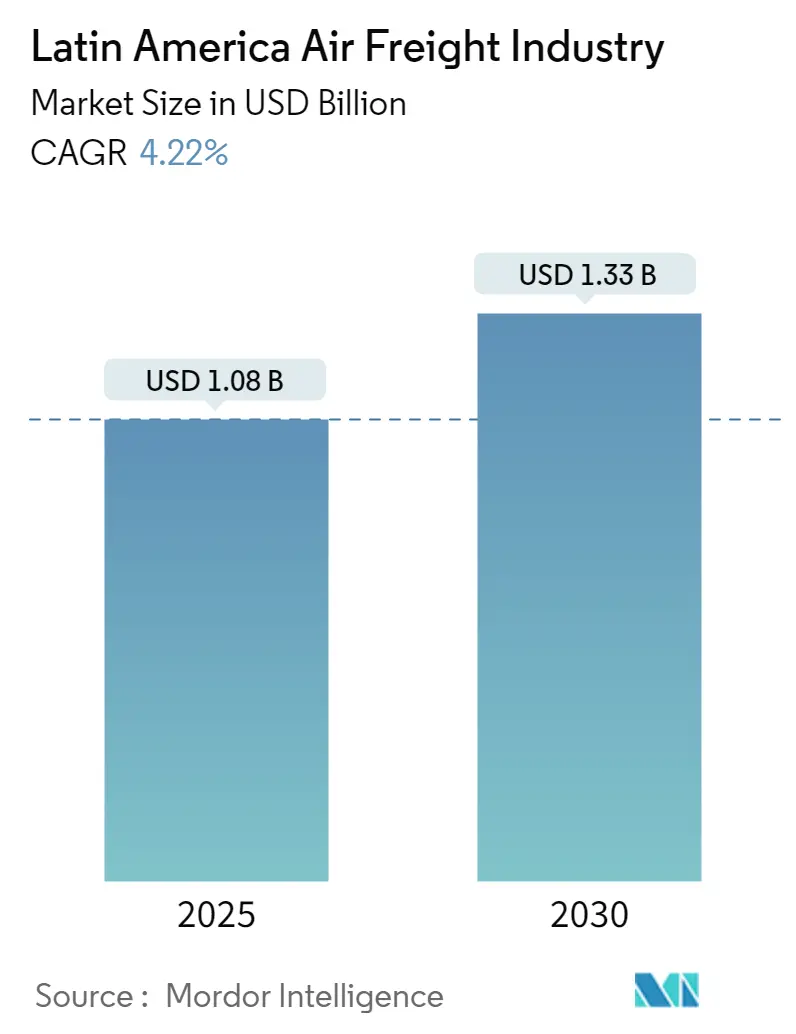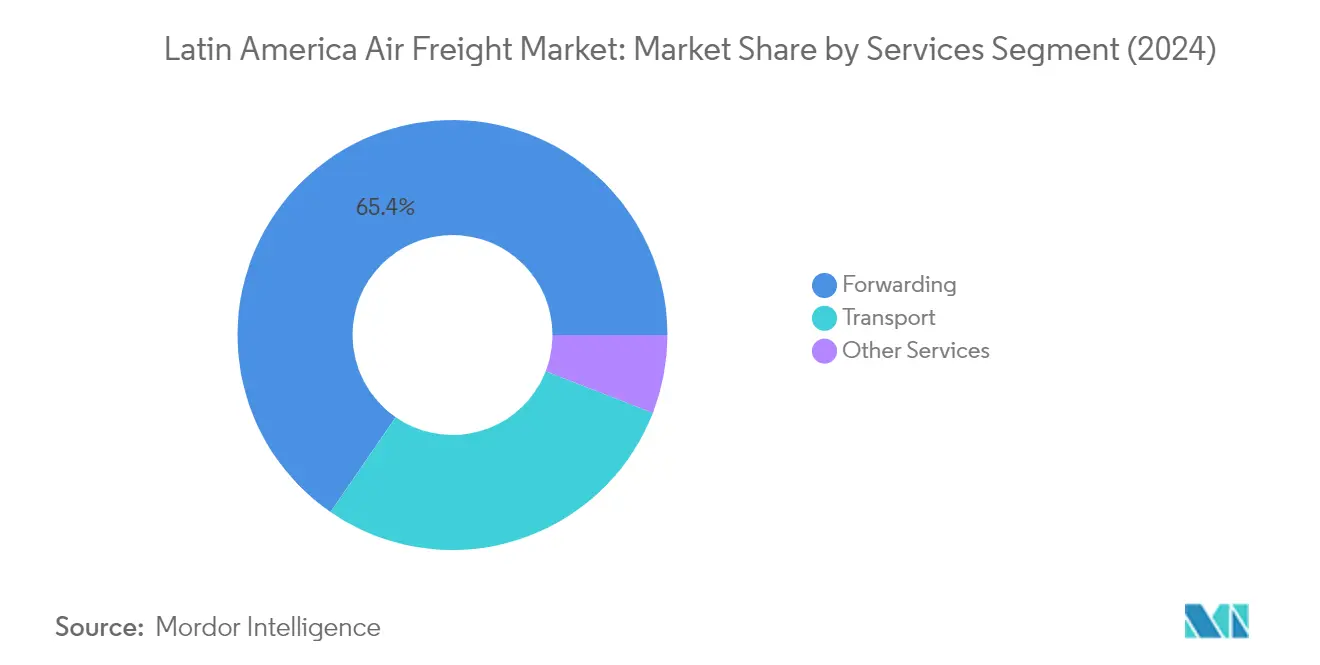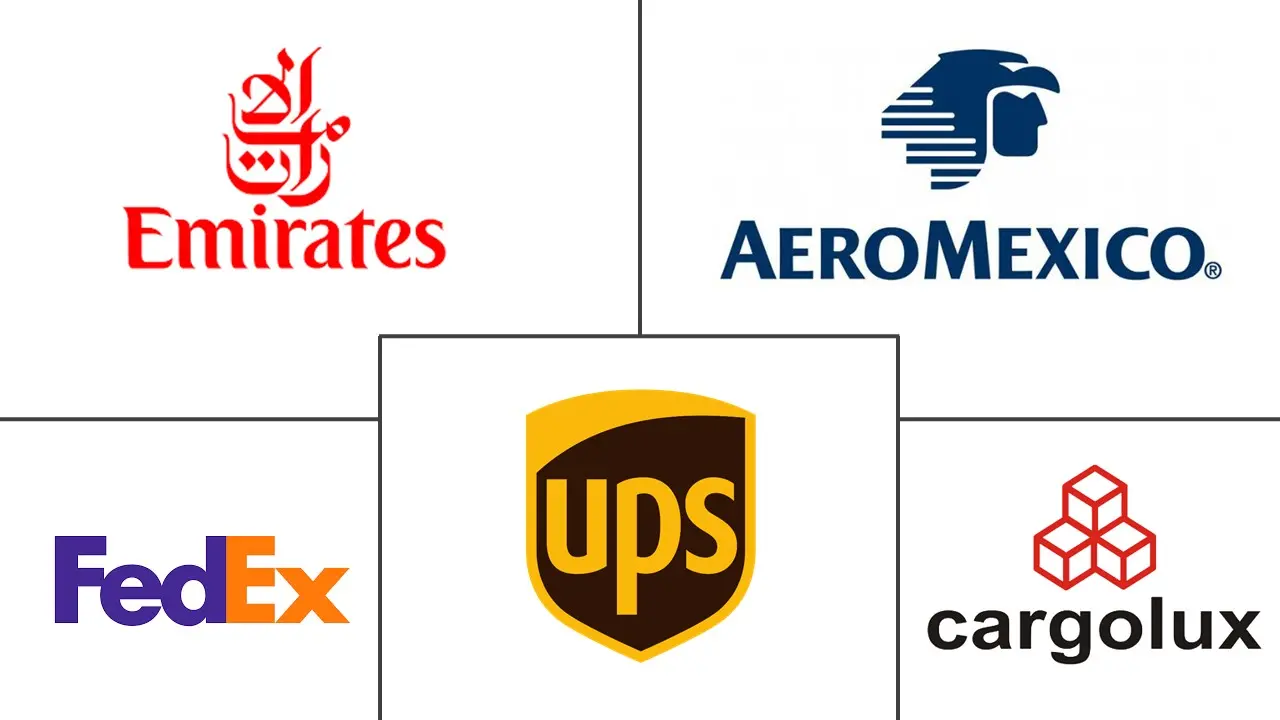
Latin America Air Freight Industry Analysis by Mordor Intelligence
The Latin America Air Freight Industry is expected to grow from USD 1.08 billion in 2025 to USD 1.33 billion by 2030, at a CAGR of 4.22% during the forecast period (2025-2030).
The Latin American air cargo industry is experiencing significant transformation driven by expanding trade relationships and infrastructure developments. The region has demonstrated remarkable resilience, with carriers achieving a notable 9.0% increase in air freight volumes in August 2022 compared to the previous year. This growth trajectory has been supported by substantial investments in modernizing airport facilities and air cargo handling capabilities across major hubs in Brazil, Mexico, and Colombia. The industry's evolution is particularly evident in the development of specialized cargo aircraft terminals and the implementation of advanced logistics technologies to enhance operational efficiency.
The sector has witnessed substantial capacity expansion and route diversification to meet growing international trade demands. In 2023, Latin American carriers achieved a 2.0% increase in demand for international air cargo operations, while capacity significantly expanded by 13.2%, with international operations specifically growing by 16.9%. This expansion has been characterized by the introduction of new routes connecting Latin America with key global markets, particularly in Asia and Europe. Major airlines have strategically increased their freighter fleets and optimized belly cargo capacity to capitalize on growing trade opportunities.
The market is experiencing a notable shift in cargo composition, with increasing emphasis on high-value perishable air cargo exports. Fresh produce, pharmaceuticals, and temperature-sensitive products have become crucial components of air transportation operations, driving investments in specialized handling facilities and cold chain infrastructure. This transformation has led to the development of dedicated perishable handling centers at major airports and the implementation of advanced temperature monitoring systems to ensure product integrity throughout the supply chain.
Despite positive developments, the industry faces challenges related to economic uncertainties and global market dynamics. The air logistics sector is experiencing fluctuating demand patterns, influenced by global economic conditions and changing consumer behaviors. Airlines are adapting their strategies by optimizing route networks, enhancing operational efficiency, and investing in digital solutions to maintain competitiveness. The focus has shifted towards developing more resilient and flexible operational models that can effectively respond to market volatility while maintaining service quality and reliability.
Latin America Air Freight Industry Trends and Insights
Growth in Cross-border E-commerce and Social Commerce
The rapid expansion of cross-border e-commerce has emerged as a significant driver for the Latin American air freight industry, fueled by several fundamental factors including a lower density of physical retail space, limited product availability, high smartphone penetration, and potential purchase savings throughout the region. The industry has witnessed substantial innovation in leveraging advanced technologies, particularly in developing fraud protection solutions and authentication technologies. These technological advancements enable key players, merchants, and banks to authenticate online shoppers effectively through solutions such as biometric data verification, creating a more secure trading environment.
Social commerce has begun to overtake traditional e-commerce in Latin America, with over half of surveyed shoppers in Brazil, Colombia, and Mexico actively participating in social commerce platforms. The trend is further strengthened by the increasing variety of payment options, with more than 40% of customers citing this as a crucial advantage. Notably, approximately one-third of social commerce transactions in Argentina, Colombia, and Mexico involve currency coupons from convenience stores, demonstrating a unique blend of digital commerce with traditional payment preferences. This evolution in commerce patterns has created sustained demand for efficient air cargo logistics services to handle the increasing volume of cross-border shipments.
Favorable Business Environment - Logistics Hub Development
The development of world-class logistics hubs across Latin America has created significant opportunities for the air cargo logistics industry. Mexico, ranked as the 15th largest exporter globally with 80% of its economic activity in the manufacturing sector, has established itself as a crucial logistics center. The country's open economy model, supported by a network of 12 free trade agreements, has transformed it into a manufacturing, engineering, and sourcing base for the North American market, driving substantial air freight movement.
The collaborative efforts among countries in the isthmus to develop a comprehensive logistics hub in the Americas have strengthened regional connectivity and trade efficiency. The Caribbean Port of Cortés in Honduras has emerged as a vital link in this network, while other strategic ports such as Acajutla and La Union in El Salvador, and Moin and Limón in Costa Rica, have enhanced the region's logistics capabilities. This infrastructure development has created a natural logistics hub that facilitates approximately USD 4.5 billion in annual trade between Central America and the United States, representing 4% of the region's total GDP.
Increasing Trade Relations and Bilateral Agreements
The strengthening of bilateral trade relations, particularly exemplified by the robust commercial relationship between Brazil and the United States, has become a significant driver for the air cargo services industry. Brazil's customs and border regulations have shown improvement, with the country ranking 52nd in the E-Freight Friendliness Index (EFFI) globally in 2022. This advancement in the regulatory framework has contributed to enhanced speed and safety in the movement of products both domestically and internationally, creating a more conducive environment for air transportation services.
The deepening of trade partnerships is evidenced by substantial bilateral trade volumes, with Brazil's trade with the United States reaching significant levels in 2023 - USD 39,122 million in exports and USD 44,808 million in imports. The freight forwarding industry has responded to this growth by developing more sophisticated logistics solutions, including improved consolidation services and streamlined customs brokerage processes. The availability of daily flights has enhanced service reliability, while experienced freight forwarding businesses have helped optimize shipment consolidation and terminal operations, leading to more efficient logistics administration and expedited shipping processes.
Segment Analysis
Forwarding Segment in Latin America Air Freight Market
The freight forwarding segment dominates the Latin American air freight market, commanding approximately 65% of the total market share in 2024. This significant market position is attributed to the segment's comprehensive end-to-end logistics solutions and its crucial role in facilitating international trade across the region. Freight forwarders in Latin America have strengthened their position by offering value-added services such as customs clearance, documentation handling, and supply chain optimization. The segment's growth is further supported by increasing digitalization trends in the freight forwarding industry, with many traditional forwarders developing dedicated digital units and enhancing their technological capabilities to meet evolving customer demands.

Forwarding Segment Growth in Latin America Air Freight Market
The freight forwarding segment is projected to maintain strong growth momentum during the forecast period 2024-2029, with an expected growth rate of approximately 8%. This robust growth is driven by several factors, including the increasing adoption of digital freight forwarding solutions, growing e-commerce activities, and the expansion of cross-border trade in the region. Freight forwarders are increasingly investing in advanced technologies such as blockchain, IoT, and artificial intelligence to enhance operational efficiency and provide better visibility to customers. The segment's growth is also supported by the rising demand for specialized forwarding services in sectors such as pharmaceuticals, perishables, and high-value electronics.
Remaining Segments in Services
The transport and other services segments play vital complementary roles in the Latin American air freight market. The transport segment focuses on the physical movement of cargo through dedicated air freight carriers and commercial airlines, providing essential air cargo capacity for the region. Meanwhile, the other services segment encompasses various specialized offerings, including packaging, warehousing, insurance, and consulting services that support the overall air freight ecosystem. These segments work in tandem with freight forwarding services to provide comprehensive logistics solutions, meeting the diverse needs of shippers and consignees across Latin America.
Segment Analysis: By Destination
International Segment in Latin America Air Freight Market
The international segment dominates the Latin American air freight market, commanding approximately 86% market share in 2024, while also demonstrating the strongest growth trajectory with a projected growth rate of around 7% through 2024-2029. This segment's prominence is driven by increasing cross-border trade activities, particularly with North America, Europe, and Asia. The expansion of e-commerce operations across borders, growing pharmaceutical trade, and the transportation of high-value goods have significantly contributed to the segment's dominance. Major airlines have been expanding their international cargo aviation routes and frequencies, particularly between key trade hubs like Mexico City, São Paulo, and Buenos Aires to global destinations. The segment has also benefited from strategic partnerships between regional and international carriers, enabling better network connectivity and improved service offerings. Additionally, investments in cold chain capabilities and specialized cargo handling facilities at major international airports have strengthened this segment's position in handling temperature-sensitive and high-value shipments.
Domestic Segment in Latin America Air Freight Market
The domestic air freight segment in Latin America, while smaller in market share, plays a crucial role in supporting internal supply chains and regional commerce. This segment primarily serves the transportation needs within individual countries, particularly in larger nations like Brazil, Mexico, and Argentina, where air transportation becomes essential due to vast geographical distances and challenging terrain. The segment has seen significant developments in infrastructure, with many airports upgrading their domestic cargo handling facilities and implementing advanced tracking systems. Domestic air freight services have become increasingly important for e-commerce fulfillment, particularly in serving remote areas and supporting just-in-time delivery requirements. The segment has also benefited from the growth of regional commerce and the increasing need for rapid distribution of time-sensitive goods like pharmaceuticals, perishables, and high-value electronics within national borders. Airlines operating in this segment have been focusing on route optimization and improving connectivity between major industrial centers and remote locations.
Segment Analysis: By Carrier Type
Belly Cargo Segment in Latin America Air Freight Market
Belly cargo continues to dominate the Latin American air freight market, maintaining approximately 61% market share in 2024, solidifying its position as the leading carrier type segment. This dominance can be attributed to the significant advantages offered by belly cargo operations, including cost-effectiveness through the utilization of existing passenger aircraft capacity and extensive route networks. The segment has shown remarkable growth potential, expected to grow at around 8% through 2024-2029, driven by increasing passenger flight frequencies, expanding airline networks, and the growing integration of cargo operations with passenger services. Airlines in the region are increasingly optimizing their belly cargo capabilities through advanced logistics solutions, digital tracking systems, and specialized handling facilities, particularly for temperature-sensitive goods and e-commerce shipments. The segment's growth is further supported by the recovery of international passenger flights, which has significantly increased available belly cargo capacity across major Latin American routes.
Freighter Segment in Latin America Air Freight Market
The freighter segment plays a crucial complementary role in the Latin American air freight market, offering dedicated cargo capacity for specialized shipments and high-volume routes. This segment has become increasingly important for handling oversized cargo, hazardous materials, and time-critical shipments that cannot be accommodated in passenger aircraft belly holds. Airlines operating in Latin America have been strategically expanding their freighter fleets to meet specific market demands, particularly in routes connecting major manufacturing hubs and key trading partners. The segment's operations are characterized by greater flexibility in scheduling, route planning, and handling capabilities, making it particularly valuable for industries requiring specialized cargo solutions. Freighter operations have also proven essential in maintaining supply chain resilience, especially during periods of passenger flight disruptions or when serving routes with limited passenger connectivity. The segment continues to evolve with investments in modern aircraft technology, enhanced ground handling capabilities, and improved operational efficiency to meet the growing demands of regional trade.
Geography Analysis
Latin America Air Freight Industry in Mexico
Mexico stands as the dominant force in Latin America's air freight landscape, commanding approximately 28% of the regional market share in 2024. The country's strategic geographical position between North and South America has established it as a crucial logistics hub, facilitating seamless trade connections across the Americas. Mexico's air freight infrastructure is anchored by key facilities including Mexico City International Airport, Guadalajara, Monterrey, Querétaro, and Toluca airports, which collectively handle over 84% of the country's air cargo operations. The nation's robust manufacturing sector, particularly in automotive and electronics, drives significant air freight demand. Mexico's commitment to modernizing its air cargo facilities and implementing advanced customs clearance systems has strengthened its position as a regional leader. The country's extensive network of free trade agreements and strong economic ties with the United States further enhance its appeal as a primary air freight destination. Recent investments in cargo-specific terminals and cold chain facilities have expanded Mexico's capabilities in handling specialized shipments, particularly in the pharmaceutical and perishables sectors.
Latin America Air Freight Industry in Argentina
Argentina emerges as the most dynamic market in the Latin American air freight sector, projected to grow at approximately 8% annually from 2024 to 2029. The country's air freight infrastructure is centered around key facilities like the Ministro Pistarini International Airport and Teniente General Benjamín Matienzo International Airport, which serve as primary gateways for international air cargo operations. Argentina's air freight market is experiencing significant transformation through technological integration and infrastructure modernization initiatives. The country's strategic focus on developing specialized cargo handling capabilities has attracted cargo airlines and logistics providers. Recent developments in cold chain logistics have particularly strengthened Argentina's position in handling temperature-sensitive cargo, especially for its thriving agricultural and pharmaceutical exports. The nation's commitment to improving air transportation connectivity and modernizing customs procedures has created a more efficient operating environment for air freight operators. The expansion of cargo-specific facilities and implementation of digital solutions for cargo tracking and management demonstrates Argentina's dedication to enhancing its air freight capabilities.
Latin America Air Freight Industry in Brazil
Brazil's air freight market demonstrates remarkable resilience and sophistication in serving South America's largest economy. The country's extensive network of airports and advanced logistics infrastructure positions it as a crucial hub for regional and international cargo airlines operations. Brazil's air freight sector benefits from strong domestic manufacturing and agricultural sectors, driving consistent demand for both internal and external cargo movements. The nation's strategic investment in modernizing air cargo facilities and implementing advanced tracking systems has enhanced operational efficiency. Brazil's commitment to sustainability in air freight operations, coupled with investments in new technologies, showcases its forward-thinking approach to market development. The country's diverse economic base, ranging from automotive manufacturing to pharmaceutical production, ensures a steady flow of high-value air cargo. Recent improvements in customs procedures and the implementation of e-freight initiatives have significantly streamlined cargo handling processes.
Latin America Air Freight Industry in Colombia
Colombia's air freight sector has established itself as a vital link in Latin America's logistics chain, leveraging its strategic geographic position between North and South America. The country's air cargo infrastructure is anchored by El Dorado Airport in Bogotá, which ranks as the leading cargo hub in South America. Colombia's air freight market benefits from a diverse export base, including fresh flowers, pharmaceuticals, and high-value manufactured goods. The nation's ongoing investments in modernizing cargo terminals and implementing advanced logistics solutions demonstrate its commitment to enhancing air freight capabilities. Colombia's strong focus on developing specialized handling facilities for perishable goods has strengthened its position in the regional market. The country's efficient customs procedures and strategic location make it an attractive transit point for international air cargo operations. Recent developments in digital tracking systems and cargo handling automation have further enhanced Colombia's competitive position in the regional air freight market.
Latin America Air Freight Industry in Other Countries
The remaining Latin American countries contribute significantly to the region's air freight landscape, each offering unique advantages and specializations. Countries like Chile, Peru, and Ecuador have developed strong niches in specific cargo segments, particularly in perishables and mining equipment transportation. The Caribbean nations serve as important transit points for international cargo routes, while Central American countries like Panama and Costa Rica leverage their strategic locations to facilitate global trade connections. These markets are characterized by ongoing infrastructure development and increasing adoption of digital solutions for air logistics management. The diversity of these economies, ranging from agricultural exporters to manufacturing hubs, creates a varied and dynamic air freight environment. Their collective contribution to the regional air freight network is essential for maintaining robust supply chain connections throughout Latin America and beyond.
Competitive Landscape
Top Companies in Latin America Air Freight Market
The Latin American air freight market features prominent global players like FedEx, UPS, Emirates SkyCargo, and DHL, alongside regional leaders such as LATAM Cargo and Avianca Cargo. Companies are increasingly focusing on technological innovation through digital platforms and automated tracking systems to enhance operational efficiency and customer experience. Strategic partnerships with e-commerce giants and investments in specialized cargo handling facilities demonstrate the industry's adaptation to evolving market demands. Operational agility is being achieved through fleet modernization programs and the introduction of fuel-efficient aircraft, while expansion strategies include route network optimization and the establishment of regional hubs. Companies are also emphasizing sustainable practices and green initiatives while developing specialized solutions for temperature-sensitive cargo and pharmaceutical transportation.
Moderately Fragmented Market with Global Dominance
The Latin American air cargo logistics market exhibits a moderately fragmented structure, characterized by the presence of both global logistics conglomerates and regional specialists. Global players leverage their extensive international networks and advanced technological capabilities to maintain market leadership, while regional carriers capitalize on their local market knowledge and established relationships. The market has witnessed significant consolidation through strategic alliances and partnerships, particularly among regional carriers seeking to enhance their competitive position against global players.
The competitive dynamics are shaped by the increasing presence of international carriers expanding their Latin American operations through acquisitions and joint ventures. Market consolidation trends are particularly evident in key markets like Brazil and Mexico, where regulatory changes have encouraged foreign investment and ownership in domestic air cargo services operations. The industry structure is evolving with the emergence of specialized cargo airlines focusing on niche segments such as perishables and pharmaceutical transportation, while traditional passenger airlines are strengthening their cargo divisions to diversify revenue streams.
Innovation and Adaptability Drive Market Success
Success in the Latin American air logistics market increasingly depends on companies' ability to innovate and adapt to changing market conditions. Incumbents are focusing on developing comprehensive end-to-end logistics solutions, investing in digital transformation, and expanding their ground infrastructure to maintain their competitive edge. The ability to offer specialized services for high-value cargo segments, maintain cost efficiency through operational optimization, and develop sustainable practices has become crucial for market leadership. Companies are also emphasizing customer-centric approaches through enhanced visibility tools and value-added services.
For contenders looking to gain market share, strategic focus areas include developing niche market expertise, establishing strong regional networks, and leveraging technology for operational efficiency. The market presents opportunities for differentiation through specialized services and regional expertise, particularly in underserved markets. Regulatory developments, particularly those related to foreign ownership and market access, continue to shape competitive dynamics. Success factors also include the ability to manage fuel cost volatility, maintain pricing power in competitive routes, and develop robust risk management strategies for economic uncertainties.
Latin America Air Freight Market Leaders
FedEx
UPS
Emirates Skycargo
Aeromexico
Cargolux
- *Disclaimer: Major Players sorted in no particular order

Recent Industry Developments
January 2024: SASI Word Inc., a global aviation consultancy in the field of air cargo logistics, has signed an agreement with Airmann Inc., located in Santiago de Chile, to launch its air cargo logistics advisory and training programs across Latin America, With offices strategically located in the United States, the United Arab Emirates, and Santiago de Chile, SASI World is based in Canada.
December 2023: DP World is building its end-to-end supply chain ambitions by launching its first cargo logistics hub. The 10,00 sq. m air cargo facility boasts features including a logistics center with warehouse and manufacturing facilities, a fuel supply terminal, and the existing warehouse.
Latin America Air Freight Industry Report Scope
The airfreight or air cargo market covers the carriage or transportation of goods by air in overseas and local markets. A complete background analysis of Latin America's air freight industry, including the assessment of the economy and contribution of sectors in the economy, market overview, market size estimation for key segments, and emerging trends in the market segments, market dynamics, and geographical trends, and COVID-19 impact, is covered in the report.
Latin America's air freight industry is segmented by services (transport, forwarding, and other services), destinations (domestic and international), carrier type (belly cargo and freighter), and country (Brazil, Mexico, Argentina, Colombia, and the Rest of Latin America). The report offers market size and forecasts for all the above segments in value (USD).
| Transport |
| Forwarding |
| Other Services |
| Domestic |
| International |
| Belly Cargo |
| Freighter |
| Brazil |
| Mexico |
| Argentina |
| Colombia |
| Rest of Latin America |
| By Services | Transport |
| Forwarding | |
| Other Services | |
| By Destination | Domestic |
| International | |
| By Carrier Type | Belly Cargo |
| Freighter | |
| By Country | Brazil |
| Mexico | |
| Argentina | |
| Colombia | |
| Rest of Latin America |
Key Questions Answered in the Report
How big is the Latin America Air Freight Industry?
The Latin America Air Freight Industry size is expected to reach USD 1.08 billion in 2025 and grow at a CAGR of 4.22% to reach USD 1.33 billion by 2030.
What is the current Latin America Air Freight Industry size?
In 2025, the Latin America Air Freight Industry size is expected to reach USD 1.08 billion.
Who are the key players in Latin America Air Freight Industry?
FedEx, UPS, Emirates Skycargo, Aeromexico and Cargolux are the major companies operating in the Latin America Air Freight Industry.
What years does this Latin America Air Freight Industry cover, and what was the market size in 2024?
In 2024, the Latin America Air Freight Industry size was estimated at USD 1.03 billion. The report covers the Latin America Air Freight Industry historical market size for years: 2020, 2021, 2022, 2023 and 2024. The report also forecasts the Latin America Air Freight Industry size for years: 2025, 2026, 2027, 2028, 2029 and 2030.



